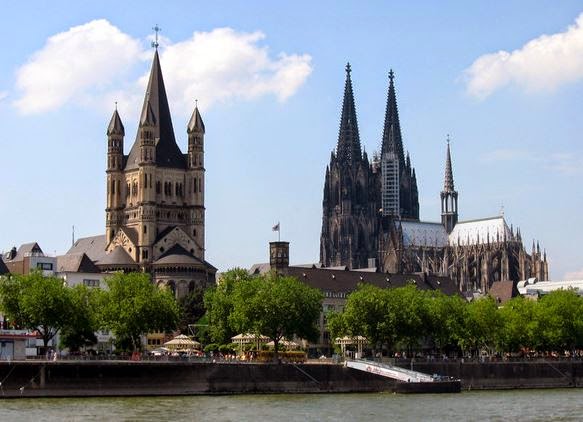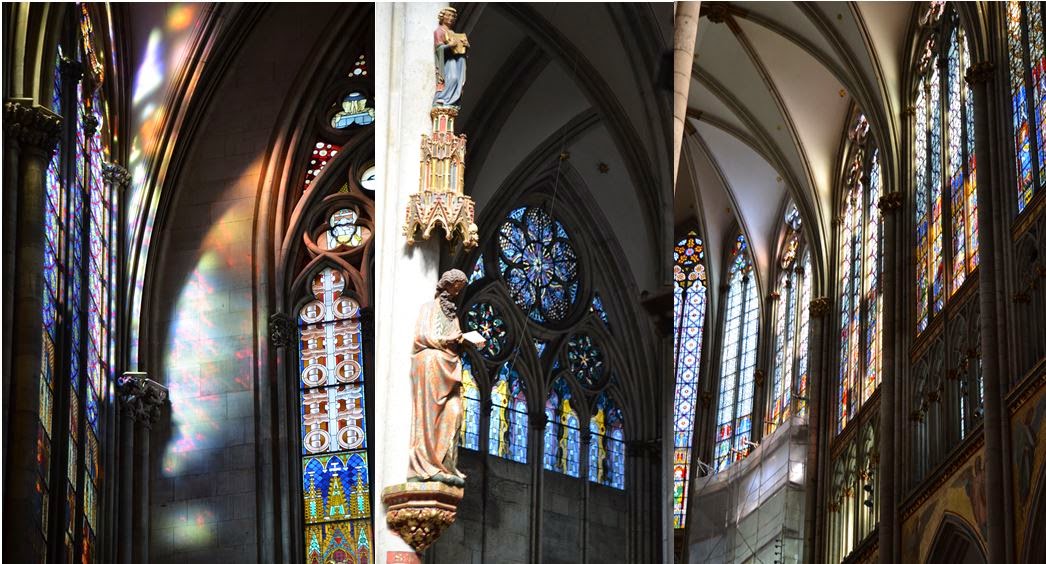 |
| Koln beside the Rhein |
 |
| Left: Skirting Munich Right: Just past Frankfurt Same day, incredible what a few hours & 400km can do to the weather! |
 |
| Coloured eggs for Easter at the breakfast buffet |
We were actually heading for Ghent for the night but after an early morning start we decided that Cologne would be a good lunch stop. M had been through with G recently on the way to a work appointment and had bought the girls back little bottles of 4711 which calls itself the original Eau de Cologne. I have fond memories of my grandmother sprinkling her handkerchief with it. M was brassed off to find out from a travel DVD he was watching (M. Portillo's Great Continental Railway Journeys Series 1 BBC) that this was not the original at all and that a story full of intrigue and deception lay at the heart of the confusion. We decided a clarifying visit to root out this tale was a higher priority than visiting the UNESCO Atomium building in Brussels which was the alternative. And we'd be able to visit the famous Cathedral as well.
One young man was sent to his uncle in Holland and became a talented merchant with a nose for a good deal. He set up shop in Cologne where non guild members were only allowed to trade in the import and export of luxury goods. With the mighty Rhein at his doorstep the young man grasped the opportunity. He set up a warehouse and a sales salon where the wealthy and influential folk of the town could select the wares they wished to purchase. Eastern spices and fabrics, french lace and oils became popular items to display wealth and the young man's ledgers started to bulge.
His brother turned up to help in the flourishing business but had a nose for another luxury good.
 |
| Top: Copyright tulip and signature Below: A gift for every person on the tour |
In the late 1600s the European world stank. Open drains, where chamber pots were emptied every morning through open windows, was the extent of plumbing. Baths were thought to be a dangerous trend and the immense costumes worn before the French Empress Josephine's influence were rarely washed. People of quality wore little bags around their necks in which to slip the small bodies of lice they caught crawling across themselves. Heavy musk oils and handheld pompadours of cloves,cinnamon and lavender were used to try and cover the stench of the heavy, powdered wigs, clammy pits and groins and breath sweetened with rotting teeth and gums. Church attendance, with incense added to the mix in close quarters saw many tight laced ladies and gentleman faint away.
The brother craved for the clean air of his country home and began to experiment with the goods in the warehouse and wrote home for fresh citrus fruit,especially the inedible bergamont oranges, to be promptly delivered. When this was unloaded in Cologne, local mothers held their toddlers above the fences and told them to drink in the smell for it would make them healthy. Rickets and scurvy were common complaints, without known cures, all through town dwelling society.
John Maria Farina distilled oils and mixed them until he was able to write this note home. “I have created a perfume which is reminiscent of a spring morning following a soft shower where fragrances of wild narcissi combine with that of sweet orange flowers. This perfume refreshes me and stimulates both my senses and imagination”. His chemistry brilliance dealt with the problem of the scent going off after a time by stabilising it in alcohol. He named this first modern perfume 'The water of Cologne' and it became instantly popular with the rich and famous when it was offered for sale in 1709. Marie Antionette's mother, Empress of the Hapsberg dynasty, ordered case fulls of it every month. In a later generation, Napoleon had his military boots fashioned with a pouch to hold a bottle for him to use without having to dismount. Records show that he used a bottle a day. The Farina brothers kept to the formulae and sent back any ordered produce that did not meet their production standards. This attention to detail and the consistent perfume produced was unheard of in the day and became the by word for luxury. (A full Rosoli bottle of 240ml for €400 in today's money)
The Farina brothers and their descendants dressed and lived like their famous customers but never let go of the practical side of their success, the chemistry or the business.
Whenever something successful happens others copy. This was certainly case in what became the Cologne battle. There was no such thing as patents as the traditional guild system managed the honesty and skill of its members. Copyright law was in its infancy and only related to printed texts at this time. Perfume was a new craft and outside of guild control.
 |
| Left: Petal outside the Farina store on Obenmarspforten 21 Above: The 4711 store below the Dom Hotel on the Cathedral square. Below: Competing advertising posters |
 |
| Our historic tour guide in store |
The talk and tour at the Farina museum cost €5 each and was fascinating. They celebrated their 300th anniversary in 2009. The building and the current Farina owners are the original. On another site they have all of the family's books, accounts and correspondence which comprises the largest unbroken archives of any Cologne business. The tour included a 4ml bottle of the original Cologne, Farina's Eua de Colonge is not gender specific. The smell reminds me of the Clarins- Eau Dynamiante(€24 for 100ml) that my Aunty H gave me for a birthday one year. It also claims theraputic benefits. Farina has other perfumes for sale, M bought a little bottle of Russian wood aftershave and Petal liked the perfume from the astrology cycle they have in store for her due date before the cusp she was born on.
In a cloud of Farina's cologne, we walked a few blocks to the gigantic Cologne Cathedral. Huge banners advertising the 'original cologne' direct you to a plush gold and teal shop opposite the Cathedral. It is easy to understand why most people have never heard of Farina when the 4711 smells fine and is marketed more intensely. It would seem that the competition between the two brands is ongoing. How do you judge who wins though - the smell that most of our grandmothers wore or the one that still has many royal warrants and regularly purchased by Lady Di and Bill Clinton?
 |
| One of the twin towers - Cologne Cathedral. Building began in 1248, it was opened in 1880 That is a long term building programme! |
 |
| Left: disappointed Petal Right: A very 1950s menu - a great selection of cakes and Easter goodies up front! |
The GPS took us out through tiny little city streets, a truck (gypsy van according to M) had gotten stuck in one of the road tunnels so we followed a couple of cars we hoped were local and ended up being able to get past the big train station covered in scaffolding and out onto the autobahn west.
We arrived in Ghent at 'B&B the Place to Be' which turned out to be in an old convent that still was gated with a curfew. This didn't effect us too much - we had thought to go for a walk around the town but were done in from the long day. Ghent isn't too far away from Calais so maybe we'll be back through again one day.
 |
| Left: Our B&B very enthusiastic and informative hostess gave us a great breakfast the next morning. Right: A facade of a house facing the convent gates. |




No comments:
Post a Comment